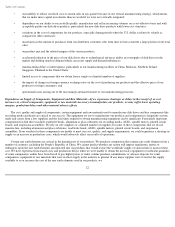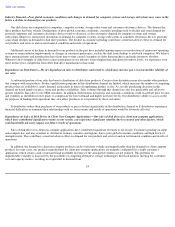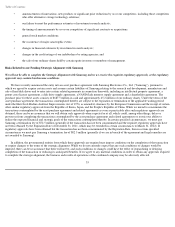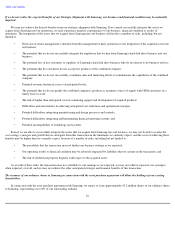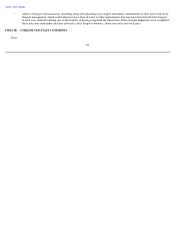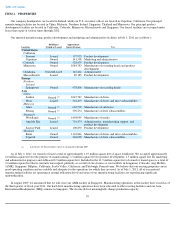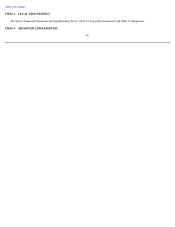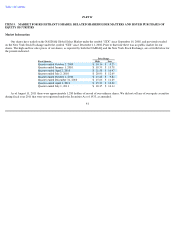Seagate 2010 Annual Report Download - page 34
Download and view the complete annual report
Please find page 34 of the 2010 Seagate annual report below. You can navigate through the pages in the report by either clicking on the pages listed below, or by using the keyword search tool below to find specific information within the annual report.
Table of Contents
We are currently subject to lawsuits involving intellectual property claims which could cause us to incur significant additional costs or
prevent us from selling our products, and which could adversely affect our results of operations and financial condition.
Intellectual property litigation is expensive and time-consuming, regardless of the merits of any claim, and could divert our management's
attention from operating our business. In addition, intellectual property lawsuits are subject to inherent uncertainties due to the complexity of the
technical issues involved, and we cannot assure you that we will be successful in defending ourselves against intellectual property claims. Patent
litigation has increased due to the current uncertainty of the law and the increasing competition and overlap of product functionality in the field.
If we were to discover that our products infringe the intellectual property rights of others, we would need to obtain licenses from these parties or
substantially reengineer our products in order to avoid infringement. We might not be able to obtain the necessary licenses on acceptable terms,
or at all, or be able to reengineer our products successfully. Moreover, if we are sued for patent infringement and lose the suit, we could be
required to pay substantial damages and/or be enjoined from using or selling the infringing products or technology. Any of the foregoing could
cause us to incur significant costs and prevent us from selling our products, which could adversely affect our results of operations and financial
condition. See Part II, Item 8. Financial Statements and Supplementary Data—Note 13, Legal, Environmental and Other Contingencies of this
Annual Report on Form 10-K for a description of pending intellectual property proceedings.
System Failures
—System failures caused by events beyond our control could adversely affect computer equipment and electronic data on
which our operations depend.
Our operations are dependent upon our ability to protect our computer equipment and the electronic data stored in our databases from
damage by, among other things, earthquake, fire, natural disaster, power loss, telecommunications failures, unauthorized intrusion and other
catastrophic events. As our operations become more automated and increasingly interdependent, our exposure to the risks posed by these types
of events will increase. While we continue to improve our disaster recovery processes, system failures and other interruptions in our operations
could have a material adverse effect on our business, results of operations and financial condition.
Economic Risks Associated with International Operations
—Our international operations subject us to risks related to currency exchange
fluctuations, longer payment cycles for sales in foreign countries, seasonality and disruptions in foreign markets, tariffs and duties, price
controls, potential adverse tax consequences, increased costs, our customers' credit and access to capital and health-related risks.
We have significant operations in foreign countries, including manufacturing facilities, sales personnel and customer support operations.
We have manufacturing facilities in China, Malaysia, Northern Ireland, Singapore and Thailand, in addition to those in the United States. A
substantial portion of our client compute disk drive assembly occurs in our facility in China.
Our international operations are subject to economic risks inherent in doing business in foreign countries, including the following:
•
Disruptions in Foreign Markets.
Disruptions in financial markets and the deterioration of the underlying economic conditions in
the past in some countries, including those in Asia, have had an impact on our sales to customers located in, or whose end-user
customers are located in, these countries.
•
Fluctuations in Currency Exchange Rates.
Prices for our products are denominated predominately in U.S. dollars, even when
sold to customers that are located outside the United States. Currency instability in Asia and other geographic markets may make
our products more expensive than products sold by other manufacturers that are priced in the local currency. Moreover, many of
the costs associated with our operations located outside the United States are denominated in local
31



